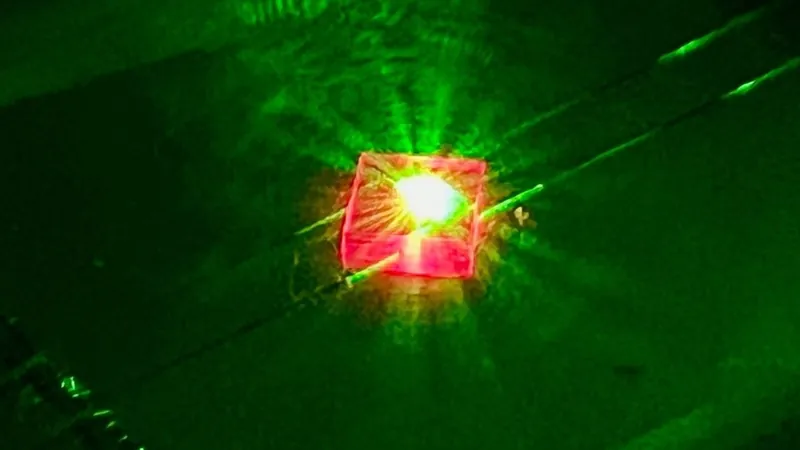
Revolutionary Discovery: Scientists Create a Unique 'Time Quasicrystal' that Challenges Our Understanding of Time
2025-03-26
Author: Arjun
Introduction
In a groundbreaking development, physicists have unveiled a new type of time crystal known as a time quasicrystal, which significantly expands our understanding of quantum interactions and material science. This extraordinary discovery could potentially revolutionize fields ranging from quantum computing to advanced sensor technology.
What is a Time Crystal?
What exactly is a time crystal? It represents a remarkable phase of matter that can exhibit perpetual motion without the loss of energy. Lead researcher Chong Zu, an assistant professor of physics at Washington University in St. Louis, explains that while a conventional crystal repeats a pattern in the spatial dimension, a time crystal repeats a motion pattern over time, effectively cycling through the same atomic arrangement indefinitely—much like a watch that never needs to be wound.
Challenges with Traditional Time Crystals
Yet, traditional time crystals are inherently delicate, easily disrupted by environmental factors. Since their theoretical introduction in 2016, researchers have faced the challenge of creating a stable version. The breakthrough came when scientists achieved the extraordinary feat of developing a time quasicrystal, which, unlike its standard counterpart, does not exhibit a repeating atomic arrangement.
Characteristics of Time Quasicrystals
This novel time quasicrystal vibrates at varying frequencies due to its non-periodic atomic structure, marking a notable departure from the predictable behavior of its predecessors. As detailed in their findings published in *Physical Review X*, the researchers described these new crystals as "ordered but apparently not periodic," hinting at a fascinating complexity that lies ahead in the study of such materials.
Engineering the Time Quasicrystals
To engineer these intricate time quasicrystals, the research team manipulated a diamond substrate, creating voids within its structure through bombardment with high-energy nitrogen beams. This innovative process displaced carbon atoms, resulting in a myriad of minuscule atomic chambers. Electrons, naturally drawn to these vacant spaces, began interacting with surrounding particles in an unprecedented manner, leading to the formation of more than a million unique configurations within each millimeter-sized piece of diamond.
Vibration and Order in Time Quasicrystals
The team utilized microwave pulses to instate rhythmic vibrations within these time quasicrystals, which not only initiate the complex behavior but also facilitate the emergence of order in time. According to MIT researcher Bingtian Ye, who contributed to the study, this technique was crucial for their success.
Implications and Applications
The implications of this unprecedented discovery extend far beyond theoretical physics. Time quasicrystals have promising applications in numerous advanced technologies. One of their most significant potential uses lies in the realm of precision timekeeping and quantum sensors. Their extreme sensitivity to environmental changes makes them ideal for crafting highly accurate sensors capable of detecting minute shifts in magnetic fields and other forces.
Moreover, in the burgeoning field of quantum computing, the anticipated perpetual motion characteristic could pave the way for storing quantum data over extended periods, akin to a quantum version of RAM. While the technology to harness these capabilities is still on the horizon, the creation of time quasicrystals marks a pivotal step forward.
Conclusion
Stay tuned—this discovery could signal a new era in both quantum science and technological innovation!


 Brasil (PT)
Brasil (PT)
 Canada (EN)
Canada (EN)
 Chile (ES)
Chile (ES)
 Česko (CS)
Česko (CS)
 대한민국 (KO)
대한민국 (KO)
 España (ES)
España (ES)
 France (FR)
France (FR)
 Hong Kong (EN)
Hong Kong (EN)
 Italia (IT)
Italia (IT)
 日本 (JA)
日本 (JA)
 Magyarország (HU)
Magyarország (HU)
 Norge (NO)
Norge (NO)
 Polska (PL)
Polska (PL)
 Schweiz (DE)
Schweiz (DE)
 Singapore (EN)
Singapore (EN)
 Sverige (SV)
Sverige (SV)
 Suomi (FI)
Suomi (FI)
 Türkiye (TR)
Türkiye (TR)
 الإمارات العربية المتحدة (AR)
الإمارات العربية المتحدة (AR)